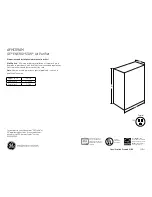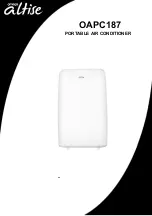
5
4. Installing the refrigerant piping
4.1. Connecting pipes (Fig. 4-1)
• When commercially available copper pipes are used, wrap liquid and gas pipes
with commercially available insulation materials (heat-resistant to 100 °C or more,
thickness of 12 mm or more).
• The indoor parts of the drain pipe should be wrapped with polyethylene foam insu-
lation materials (specific gravity of 0.03, thickness of 9 mm or more).
• Apply thin layer of refrigerant oil to pipe and joint seating surface before tightening
flare nut.
• Use two wrenches to tighten piping connections.
• Use refrigerant piping insulation provided to insulate indoor unit connections. Insu-
late carefully.
A
Flare cutting dimensions
Copper pipe O.D.
Flare dimensions
(mm)
øA dimensions (mm)
ø6.35
8.7 - 9.1
ø9.52
12.8 - 13.2
ø12.7
16.2 - 16.6
ø15.88
19.3 - 19.7
ø19.05
23.6 - 24.0
B
Flare nut tightening torque
Copper pipe O.D.
Flare nut O.D.
Tightening torque
(mm)
(mm)
(N·m)
ø6.35
17
14 - 18
ø6.35
22
34 - 42
ø9.52
22
34 - 42
ø12.7
26
49 - 61
ø12.7
29
68 - 82
ø15.88
29
68 - 82
ø15.88
36
100 - 120
ø19.05
36
100 - 120
*1: The flare nut is attached to its pipe.
*2: The flare nut is in the outdoor unit accessory.
Do not use the flare nut attached. If it is used, a gas leakage or even a pipe
extraction may occur.
Refer to the outdoor unit installation manual for the specification of connecting pipes.
90
°
±
0.5
°
ø
A
R0.4~R0.8
A
45
°±
2
°
B
C
D
Fig. 4-1
C
Apply refrigerating machine oil over the entire flare seat surface.
D
Use the flare nuts as follows.
4.2. Positioning refrigerant and drain piping
1
Position of refrigerant and drain piping (Fig. 4-2)
• The drain pipe can be cut midway to meet the on-site conditions.
A
(Total length of flexible hose)
D
Drain hose
B
Liquid pipe
E
Left-side piping
C
Gas pipe
F
Right-side piping
Fig. 4-2
Fig. 4-4
E
D
B
C
A
C
B
D
F
35
449
581
280
31
54
86
153
700
A
E
60
10
22
70
21
245
D
8
B
E
D
10
190
22
70
35
8
60
C
E
8
60
10
22
70
21
245
D
Fig. 4-3
1
A
B
C
D
E
F
G
4.3. Refrigerant piping (Fig. 4-4)
Indoor unit
1. Remove the flare nut and cap of the indoor unit.
2. Make a flare for the liquid pipe and gas pipe and apply refrigerating machine oil
(available from your local supplier) to the flare sheet surface.
3. Quickly connect the on site cooling pipes to the unit.
4. Wrap the pipe cover
3
that is attached to the gas pipe and make sure that the
connection join is not visible.
5. Wrap the pipe cover of the unit’s liquid pipe and make sure that it covers the
insulation material of the on site liquid pipe.
6. Use the bands that are provided
4
to tighten both ends (15–20mm) of each pipe
cover
3
.
A
Cooling pipe and insulation (available from local supplier)
B
Unit’s gas pipe
E
Bands
4
C
Unit’s liquid pipe
F
On site gas pipe
D
Pipe cover
3
G
On site liquid pipe
2
2
Determine the position of the knockout holes on the unit body. (Fig. 4-3)
s
Cut the knockout holes using a saw blade or an adequate knife.
Take care not to damage other parts of the unit.
• Remove the corner box and drill a knockout hole. If a hole is made without remov-
ing the box, the drain hose could be damaged.
A
Left-side piping
D
Remote controller cable through hole
B
Lower piping
E
Corner box
C
Right-side piping
Indoor unit
RP1.6, 2
RP2.5, 3
RP4-6
Refrigerant
R407C
Joint outdoor unit
PU(H)-P1.6/2 PU(H)-P2.5/3 PU(H)-P4/5/6
Gas side
Pipe size (mm)
ø15.88
ø15.88
ø19.05
Indoor nut
*1
*1
*1
Outdoor nut
*1
*1
*1
Liquid side
Pipe size (mm)
ø9.52
ø9.52
ø9.52
Indoor nut
*1
*1
*1
Outdoor nut
*1
*1
*1
Indoor unit
RP1.6, 2
RP2.5, 3
RP4-6
Refrigerant
R410A
Joint outdoor unit
PUHZ-RP1.6/2 PUHZ-RP2.5/3 PUHZ-RP4/5/6
Gas side
Pipe size (mm)
ø12.7
ø15.88
ø15.88
Indoor nut
*2
*1
*2
Outdoor nut
*1
*1
*1
Liquid side
Pipe size (mm)
ø6.35
ø9.52
ø9.52
Indoor nut
*2
*1
*1
Outdoor nut
*1
*1
*1



























